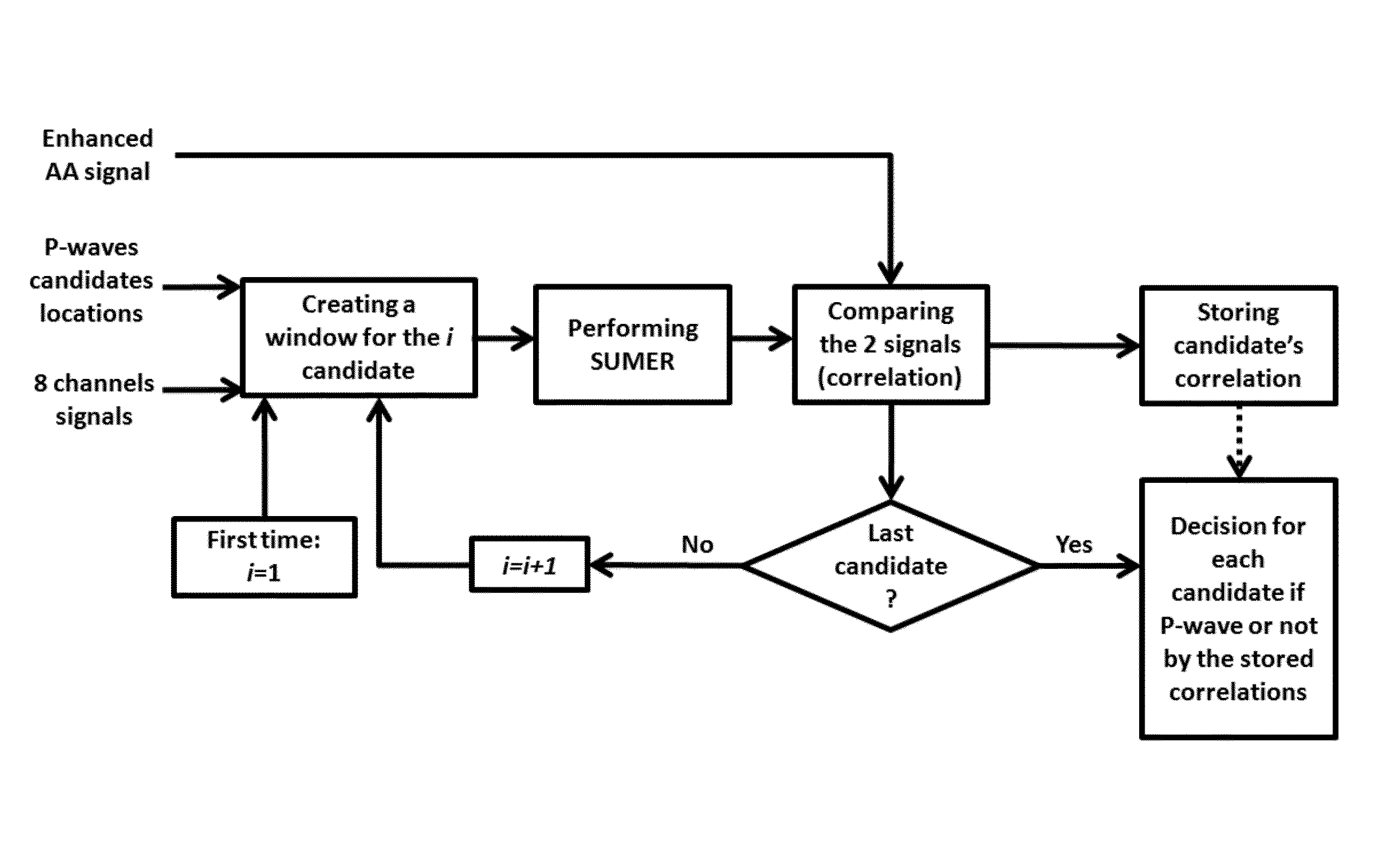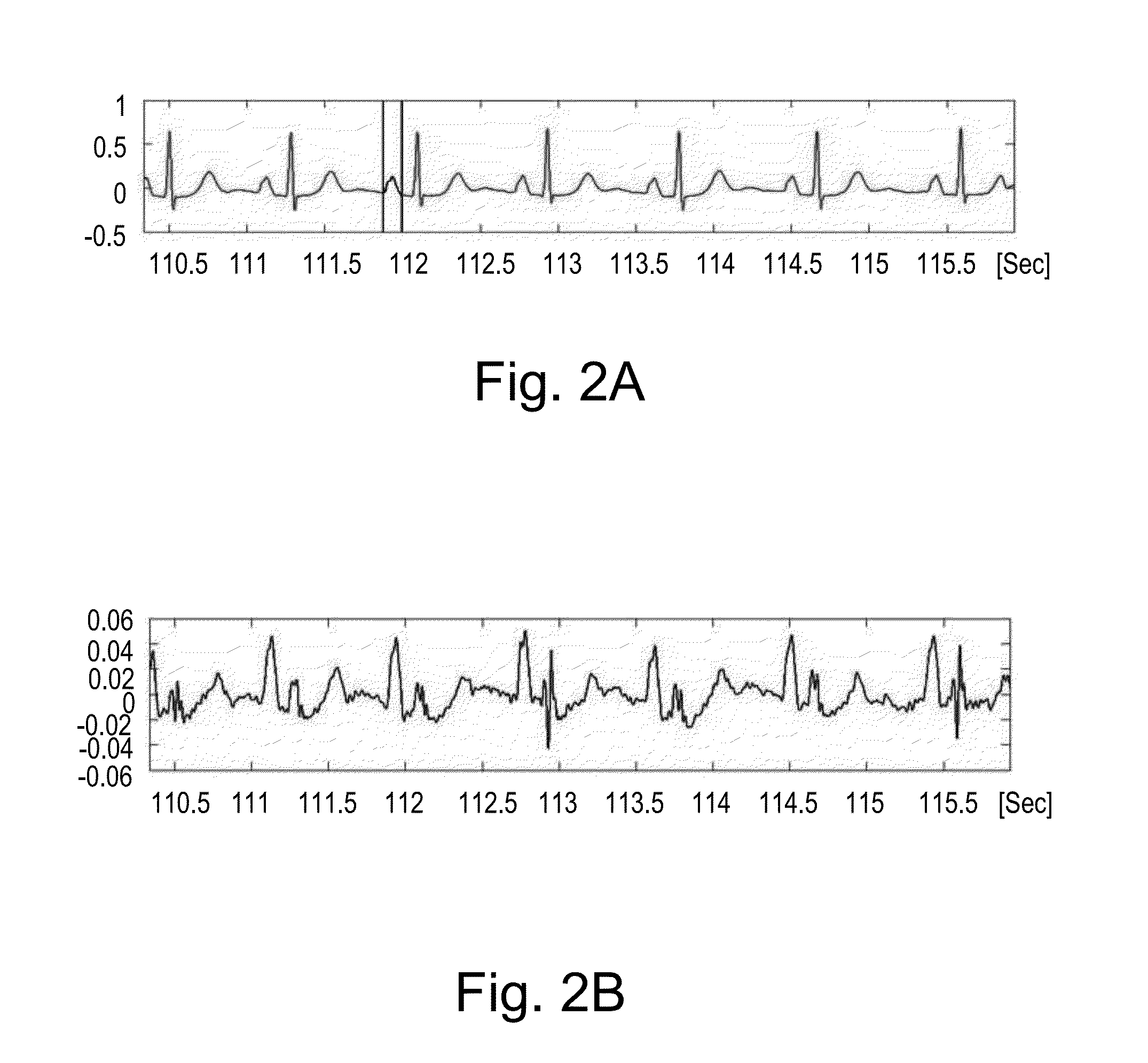Method and system for detecting P-waves in the surface ECG signal
a technology of ecg signal and detection method, which is applied in the field of method and system for detecting p-waves in ecg signal, can solve the problems of relatively difficult detection of aa and unsolved detection of p-waves
- Summary
- Abstract
- Description
- Claims
- Application Information
AI Technical Summary
Benefits of technology
Problems solved by technology
Method used
Image
Examples
example 1
[0056]The use of the SUMER algorithm was demonstrated in this example on an 8-lead signal (FIG. 4A), by using a synthetic AA signal (FIG. 4B). Assuming that there is a linear combination of the 8 lead signals that reconstructs the AA signal, the way was looked for to force a linear combination to converge to a signal that is similar to the AA signal. At first, using a-priori knowledge of the P-wave locations (using the HRA signal in some cases, or simply by looking at lead signal in cases like sinus rhythm) was used to mark the location of the P-waves. Next, chosen was a certain shape of for a rectangular or Gaussian peak with width of the P-waves in the signal. The shape should imitate a P-wave. Reconstructed signal emphasized the P-waves (FIG. 4C).
example 2
[0057]This example demonstrates some features of employing linear combinations of ECG signals, and simulates the work of SUMER technique. It is supposed that signal S1 is associated with ventricular activity and signal S2 with atrial activity (FIG. 5). Surface ECG measures the heart activity using two leads, denoted I and II, measuring the heart activity from different sites (angles). For the sake of this example, it is supposed that lead I is equal to S1+S2 and lead II is equal to S1+0.5*S2. In other words, lead I is a linear combination of the sources with weight coefficients (1,1) and lead II is a linear combination of the sources with weight coefficients (1,0.5) (FIG. 6). Now, one segment in the simulated ECG lead is marked as P-wave, and a linear combination of the two leads is searched for that will produce the highest ratio between the marked segment's energy and the non-marked segment's energy. The energy ratio will get its maximum when the QRS complexes will reduce to zero....
example 3
[0058]Applying SUMER (Separation Using Maximum Energy Ratio) technique on ECG signals is further demonstrated in this example. A flowchart is shown in FIG. 8. Employed are steps of filtering 8 channels, segmenting the channels into marked and non-marked segments (AA and NAA), subtracting of the mean of each segment, creating a cost function of the energy ratio between the AA segment and the NAA segment with initial coefficients for the linear combination, optimization of the cost function to its maximum by changing the coefficients using gradient ascent method until converging to a fixed value. In a simulation, there is atria-associated signal (FIG. 9A) and ventricles-associate signal (FIG. 9B); two lead signals are simulated as linear combination of the atrial and ventricular activity: Lead 1=AA+VA (FIG. 10A) and Lead 2=VA−AA (FIG. 10B). The solution to get only the AA is Lead1−Lead2. And the solution to get only the VA is Lead1+Lead2. So the coefficients (c1, c2) will give us the ...
PUM
 Login to View More
Login to View More Abstract
Description
Claims
Application Information
 Login to View More
Login to View More - R&D
- Intellectual Property
- Life Sciences
- Materials
- Tech Scout
- Unparalleled Data Quality
- Higher Quality Content
- 60% Fewer Hallucinations
Browse by: Latest US Patents, China's latest patents, Technical Efficacy Thesaurus, Application Domain, Technology Topic, Popular Technical Reports.
© 2025 PatSnap. All rights reserved.Legal|Privacy policy|Modern Slavery Act Transparency Statement|Sitemap|About US| Contact US: help@patsnap.com



